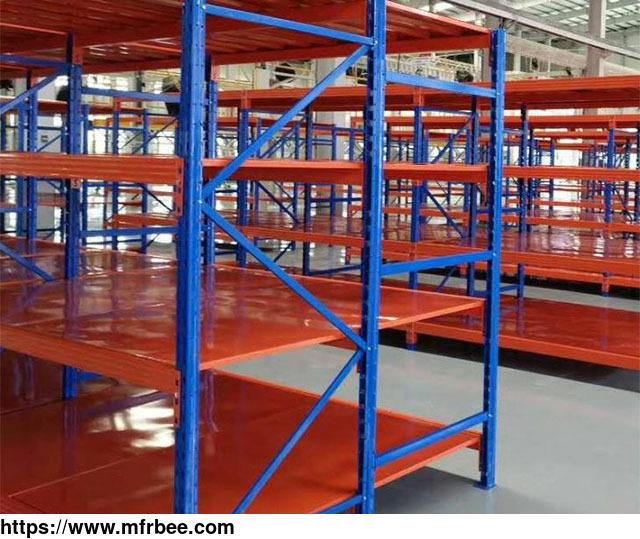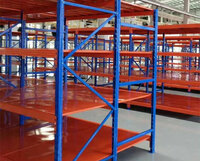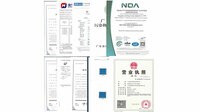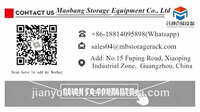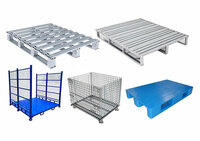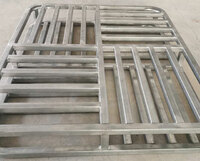MEDIUM DUTY SHELVING RACK 300KG
Specifications
Using steel laminates, columns and beams, the entire medium duty shelving 300 KG is not connected by bolts, which is easy to install and disassemble. The main and sub-connection form is adopted,
and the stability of wide span shelving units is strong.
The Advantage Of Warehouse Medium Duty Shelves Racking
The upright group of medium duty shelving is an assembled structure, and the beam and the upright group are connected by a steel buckle card, and are locked with a safety key to prevent falling
off.
The column of medium duty shelves has an adjustment hole distance every 55mm, which can be adjusted the height for each layer.
Adjacent columns in the back-to-back direction can be used to strengthen the connection, and the bottom of the column and the ground can be used with ground nails to improve safety and reliability.
Heavy-duty storage shelves are suitable for the use of ordinary people or stackers for unloading goods, and for enterprises with a large storage capacity. You can check our cases of heavy duty rack
philippines.
Medium-sized shelves are suitable for storing light and small items; Medium duty shelving isoften used in electronics, clothing, medicine, food, e-commerce warehousing, cross-border e-commerce,
etc.
Medium Duty Rack 300KG FAQs
What kind of surface treatment do you provide for the medium duty shelving racks?
Powder coating. It can also be made according to our customers' requirements for medium duty shelves racking.
What is the standard process for me to order medium duty shelves racking?
Medium duty shelving racks with solution design, drawing approval, pricing, order confirmation, deposit, manufacturing, inspection, balance payment, delivery.
Are you a trading company or a factory?
We are medium duty shelving racks factory.
How to pack the medium duty shelving racks?
Medium duty shelves racking can be packed in stretch film and cartons.
What payment terms can you use?
We accept 30% of TT depositors, and the balance is arranged for re-shipment, or for immediate BL or L/C, DP, etc.
What is medium duty shelves racking weight bearing capacity?
100 to 5000kgs bearing weight capacity for medium duty shelving racks
What is the minimum order quantity I can order?
There is no MOQ, but it is better to use 1*20GP, which can save you the cost of loss.
What is your average production lead time?
Within 7 to 20 days
I am not sure about your medium duty shelving racks, can you send me samples for reference?
In addition to shipping, our standard medium duty shelves racking samples are free.
For customized medium duty shelves racking, sample fees and shipping costs will be charged.
like your design, but I can’t find a suitable model from the catalog. Can I customize the medium duty shelves racking size?
Yes, we are good at producing medium duty shelving racks according to your design.
What should I do if the medium duty shelves racking has any quality problems?
Just contact us via our phone or email. We will deal with it as soon as possible. The warranty period is 2 years.
What are the main differences between medium duty shelves and heavy-duty shelves, and when should one opt for medium duty shelves instead?
Medium duty shelves and heavy-duty shelves are two distinct categories of storage solutions, each catering to different storage requirements based on load capacity, durability, and intended usage.
Understanding the main differences between these two types of shelves is crucial for businesses to make informed decisions when selecting the most appropriate storage solution for their needs.
Load Capacity:
The primary difference between medium duty shelves and heavy-duty shelves lies in their load-bearing capacity. Heavy-duty shelves are designed to support significantly heavier loads compared to
medium duty shelves. Heavy-duty shelves typically have load capacities ranging from 1000 kg to several tons, making them suitable for storing large and heavy items, such as machinery parts,
industrial equipment, or bulk products. On the other hand, medium duty shelves have lower load capacities, generally ranging from 300 kg to 800 kg. They are more suitable for storing medium-weight
items, like electronic components, office supplies, or smaller inventory items.
Construction and Materials:
Due to the difference in load capacity, heavy-duty shelves are constructed with thicker, sturdier materials and more robust welding or boltless connections. They often use high-quality steel or
other heavy-duty materials to ensure structural integrity and stability under the immense weight they support. In contrast, medium duty shelves are constructed using lighter materials, offering a
balance between strength and cost-effectiveness. While they may not be as robust as heavy-duty shelves, they are still durable enough to withstand moderate loads and day-to-day usage.
Intended Usage:
The choice between medium duty shelves and heavy-duty shelves largely depends on the nature of the items being stored and the frequency of access. Heavy-duty shelves are best suited for industrial
or manufacturing settings where large and heavy items need to be stored and accessed regularly. They are also commonly used in warehouses or distribution centers to accommodate palletized goods.
On the other hand, medium duty shelves are more commonly found in commercial settings, offices, retail stores, or small warehouses where the stored items are lighter and smaller in size. They are
ideal for organizing items that need to be easily accessible without requiring heavy machinery or equipment.
Cost Considerations:
The cost difference between medium duty shelves and heavy-duty shelves is another crucial factor to consider. Heavy-duty shelves, with their higher load capacity and more robust construction, tend
to be more expensive than medium duty shelves. Businesses should assess their budget and prioritize their storage needs to determine which option aligns best with their financial constraints and
operational requirements.
The choice between medium duty shelves and heavy-duty shelves boils down to load capacity, construction, intended usage, and budget considerations. When opting for medium duty shelves, businesses
with lighter storage requirements and smaller items will find them to be a cost-effective and efficient solution. On the other hand, heavy-duty shelves are a better fit for industries handling
large, heavy items that demand durable and robust storage solutions. By carefully evaluating their specific needs, businesses can make the right choice to optimize their storage space and improve
overall efficiency.
As a warehouse racking supplier, we can offer sorts of high density warehouse storage systems for sale, if you are interested, please leave us a message.
- Country: China (Mainland)
- Business Type: Manufacturer
- Market: Asia,Americas
- Founded Year: 2009
- Address: No.15 Fuping Road, Xiaoping Industrial Zone, Shatou Street, Panyu District, Guangzhou
- Contact: Mao bang
